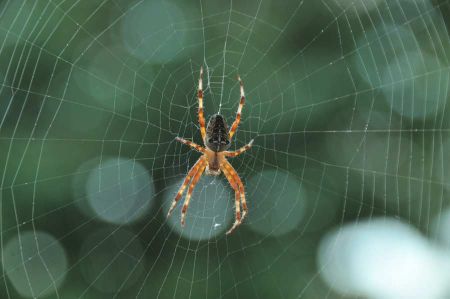Artists in web construction - the cross spiders
- Written by Portal Editor
Autumn is slowly approaching and thus the nights are getting cooler and dampness rises, which then clings to bushes and trees as morning dew; but especially in the cobwebs, the fine droplets in the network give a bizarre picture.
If, with a bit of luck, the sun shines a little through the cobwebs, really interesting colour reflections often appear. We were just observing one such spider web that morning when tiny tremors shook the web. The "owner" of this work of art was also at the centre of what was happening in the network in a flash: a large garden spider.
Cross spider - in 2010 the spider of the year
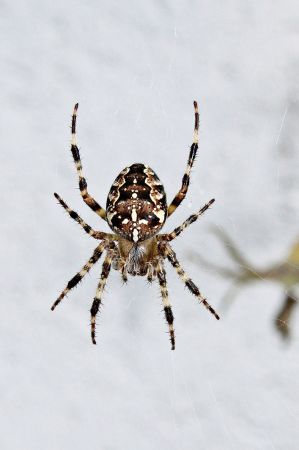 Now, we all learned the basics about spiders at school, such that the garden spider, with several hundred species distributed worldwide, is one of the most species-rich genera from the family of orb-weaver spiders and also belongs to the poisonous spiders, but we really have extensive not busy us with this everyday animal. The garden spider native to us is probably the most well-known species of this spider genus, in 2010 it was even the spider of the year.
Now, we all learned the basics about spiders at school, such that the garden spider, with several hundred species distributed worldwide, is one of the most species-rich genera from the family of orb-weaver spiders and also belongs to the poisonous spiders, but we really have extensive not busy us with this everyday animal. The garden spider native to us is probably the most well-known species of this spider genus, in 2010 it was even the spider of the year.
There are about 10 species of cross spiders in Central Europe. And yes, garden spiders are also poisonous spiders that kill their prey with a bite. However, the poison of the garden spider is not dangerous for humans, more comparable to a mosquito bite. In addition, garden spiders only have rather short venomous claws that can hardly penetrate human skin. The bites of European spiders are particularly dangerous for people with allergies, in whom the bite can trigger an allergic shock. This leads to shortness of breath and circulatory problems, which in the worst case can be fatal. Anyone who knows they are allergic to insect bites should always have their personal emergency kit with them - it can be life-saving!
In order of toxicity - the thorn finger spider
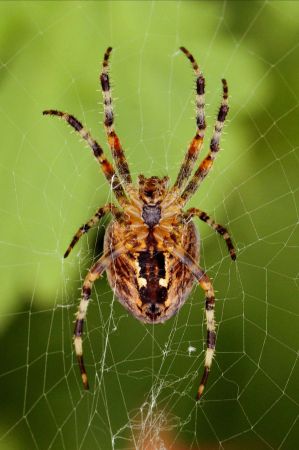 The most venomous European spider is the black widow, but its dangerousness is greatly exaggerated. Its Latin name is "latrodectus", which means "secret biter".
The most venomous European spider is the black widow, but its dangerousness is greatly exaggerated. Its Latin name is "latrodectus", which means "secret biter".
Fifteen minutes after the barely visible bite, the first symptoms appear and continue to increase in the hours that follow.
This includes severe pain, tears and salivation increases sharply and you are plagued by nausea. After about 24 hours everything should be over. In severe cases, an antidote called an antiserum can be given.
Next in order of toxicity comes the thorn finger spider, which can be found in the Rhine-Main area and on the Kaiserstuhl. Their bite can be very painful, but is rarely fatal.
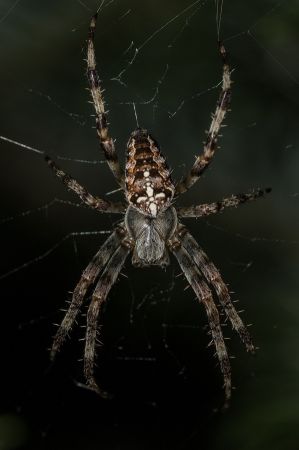 Garden spiders get their name from the characteristic cross on the front abdomen, which consists of five spots (four oblong and one circular in the middle) in the garden spider and four spots in the four-spot spider.
Garden spiders get their name from the characteristic cross on the front abdomen, which consists of five spots (four oblong and one circular in the middle) in the garden spider and four spots in the four-spot spider.
The spots are metabolic products that are deposited under the chitin shell.
However, not all species of the genus Araneus also have these spots arranged in a cross shape; most species have a different pattern.
The basic colour of the spider is very variable. She can change her colouring to match the brightness of her surroundings.
When the spider is full, it spins up all of its prey
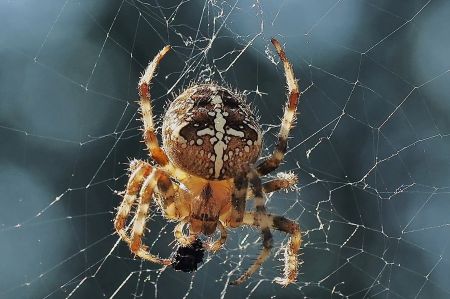 Garden spiders feed on any insect they can catch in their webs, including wasps, bumblebees, bees, flies, and butterflies. The prey caught in the net is grabbed in front of the jaws with small tentacles.
Garden spiders feed on any insect they can catch in their webs, including wasps, bumblebees, bees, flies, and butterflies. The prey caught in the net is grabbed in front of the jaws with small tentacles.
The tentacles are hollow and can inject the spider venom into the prey. Depending on the size of the prey, this leads to paralysis or death of the prey. With a band of secretion of varying width from the spinning glands, the spider wraps around its prey, turning the prey rapidly with its legs.
After paralyzing the prey, the spider injects digestive juices into the victim so that the edible components within the chitinous layer dissolve and then sucks it out. When the spider is full, it wraps up all of its prey and hangs it in its web as a supply.
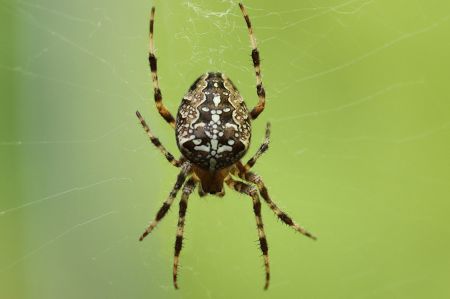 Which brings us to the really artistic network of the garden spider. We were lucky enough to be able to observe this web construction directly, because our magnificent specimen was probably not really satisfied with the location initially chosen. In addition to the artistic way in which the net was made, we were particularly surprised by the speed of construction.
Which brings us to the really artistic network of the garden spider. We were lucky enough to be able to observe this web construction directly, because our magnificent specimen was probably not really satisfied with the location initially chosen. In addition to the artistic way in which the net was made, we were particularly surprised by the speed of construction.
First, the frame is made from individual threads that are hung on the branches. The carrying thread is clearly visible and much stronger because it is supposed to carry the net. Then spoke threads are pulled into the net and then a spiral of sticky catch threads is spun in. Our spider needed about 40 minutes for a 20-centimeter orb web with about 18 meters of thread length, which were needed for production.
The spiders use so-called "hearing hairs" on their legs
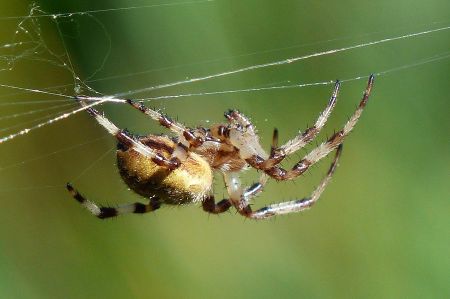 These threads are spun from their 400 to 600 tiny glands on their abdomen. The webs of the garden spider can be very large (up to 50 cm) and are tightly woven. Like many orb-weaver spiders, the garden spider always keeps its web in order so that it is not easily recognizable by prey hanging in the web. Striking and tech-savvy is the ability to create threads of various types. On the one hand sticky threads for the safety nets, on the other hand very strong threads for attaching the nets.
These threads are spun from their 400 to 600 tiny glands on their abdomen. The webs of the garden spider can be very large (up to 50 cm) and are tightly woven. Like many orb-weaver spiders, the garden spider always keeps its web in order so that it is not easily recognizable by prey hanging in the web. Striking and tech-savvy is the ability to create threads of various types. On the one hand sticky threads for the safety nets, on the other hand very strong threads for attaching the nets.
As with all spiders of the genus Araneus, the eggs of the garden spider overwinter in the cocoon. The young spiders hatch between April and May of the following year. In this first summer they form an intermediate generation that overwinters and only matures in the following summer.
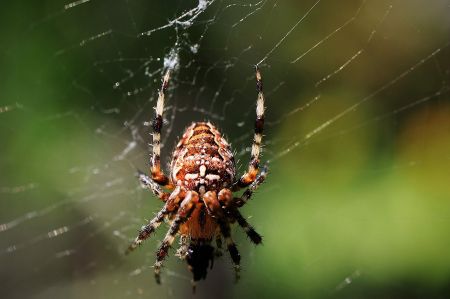 Since the spiders are cold-blooded animals, they look for a sheltered place to hibernate, mostly in plant remains or crevices in the ground. Mating with the mature females then begins in August, which is often life-threatening for the males. They are often eaten by the female. The males spin an application thread onto the web of the female and pluck it. Since spiders are very sensitive to shocks, the female recognizes the male by the plucking. The spiders use so-called "hearing hairs" on their legs. If the female is willing to mate, she leaves the middle of the net and goes to the application thread. The pairing lasts only a few seconds and is usually repeated several times. In autumn, the female lays her eggs in yellow cocoons made of thread wool. She usually dies over the last cocoon.
Since the spiders are cold-blooded animals, they look for a sheltered place to hibernate, mostly in plant remains or crevices in the ground. Mating with the mature females then begins in August, which is often life-threatening for the males. They are often eaten by the female. The males spin an application thread onto the web of the female and pluck it. Since spiders are very sensitive to shocks, the female recognizes the male by the plucking. The spiders use so-called "hearing hairs" on their legs. If the female is willing to mate, she leaves the middle of the net and goes to the application thread. The pairing lasts only a few seconds and is usually repeated several times. In autumn, the female lays her eggs in yellow cocoons made of thread wool. She usually dies over the last cocoon.
With a little rest from observation, a normal morning turned into an almost adventurous research day at home.
Please read as well:
